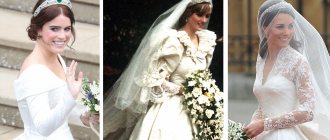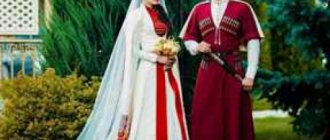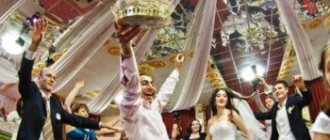The ancestors of today's Chuvash considered birth, marriage and death to be the most significant events in life.
The customs that accompany these important events are called rites of passage. It is believed that at birth and at death, a person simply makes a certain transition to another world. A wedding is an event that radically changes a person’s position in society and his way of life, and marks a transition to another social group. For a person of Chuvash nationality, it is considered a great sin and generally a misfortune to die without getting married. The goal of every person’s life was to create a family and continue the family line, raising offspring.
Coming into this world, each person must leave his mark, his continuation on this earth. Continuation of the beliefs of the Chuvash in their children. According to customs, you are supposed to not only give birth to children, but also teach them everything that you yourself can do and everything that your parents taught you.
Scientists note in the Chuvash national tradition a concern not so much for oneself, but for one’s family, its well-being, and strengthening the position of one’s family. Thus, they believed that they held an answer to their ancestors and kept it with dignity if the clan rose over the generations.
The national peculiarity of the Chuvash is that they do not care about preparing for the future life, but about improving the position of their family. Everything was done for this.
Mysteries of the Chuvash people
Chuvash wedding rituals are closely interconnected with everyday and religious legends. Everyday customs include bride price and dowry. Religious legends make it possible to save a family from evil spirits and the evil eye, as well as attract happiness and wealth.
The entire wedding process lasts for several weeks and is based on many steps from meeting the newlyweds to marriage.
Dating young people
To find his beloved, the groom had to travel beyond the borders of his native area. This gave confidence that the future wife would not be in a family relationship with the chosen one. Residents of the same village could be relatives to each other. And according to the rules, it is strictly forbidden to marry a girl from your inner circle.
For the same reason, many settlements took part in the celebration, where young people got to know each other. There were also cases where the father and mother chose the groom’s couple. But they always consulted with both the boy and the girl before entering into marriage. If there is sympathy between the parties, it is necessary to give gifts. Women are presented with scarves, and men are presented with various treats.
Choosing a future spouse
After the groom has chosen his betrothed, he talks about his answer to his family. Before the wedding celebration, father and mother must make sure that a healthy and well-mannered woman is invited to the home. Since the future wife will be the mistress of the house, she must keep order. The girl’s skills were carefully checked by her relatives. Mature women are valued more, as they have a substantial dowry and experience in housekeeping.
Matchmaking process
Most often, matchmaking takes place in the spring. Matchmakers are sent to the future wife. The team includes numerous relatives and close family members. But there is a distinctive feature - the number of matchmakers is always odd. Residents who have been chosen appear at the girl’s home with treats and drinks. If the parents make the choice, then the groom is taken to the first reception. If a man does not appreciate a woman, then the young man can calmly refuse her. Then the matchmaking process begins again.
After arriving at the bride's house, the groom's relatives start a usual conversation with the girl's parents. This is done consciously, as tradition requires. If the first visit went well, then a second meeting with the future spouses was scheduled.
Some moments of matchmaking
If the matchmakers discussed all the points with the bride’s relatives, then after 2-5 days the future wife’s side came for a visit. Such a meeting made it possible to consolidate acquaintance and conclude an agreement on bridewealth and dowry. Both sides exchange treats. The bride must present gifts to her chosen one's relatives.
Negotiations about a future event take place at the table. The wedding day was scheduled after 3 or 5 weeks. The main requirement is that the holiday is held on an odd week.
The dowry includes kitchen utensils, clothing and livestock. Kalym consisted not only of money, but also of food for celebration. Such customs of the Chuvash people are still used today. Only now everything is defined in monetary values.
The giving of the bride price takes place a few days before the event. The bride's relatives place bread and salt on the table, and the groom's relatives cover it with a bag of money. The girl's father or grandfather takes the bride price, and gives the bag with the enclosed coin back. This custom is necessary to ensure that the house never runs out of money.
How does matchmaking and engagement work?
A Chuvash wedding is inextricably linked with the performance of various household traditions and religious rituals. According to the existing traditional canons of peoples
Chuvashia, the groom is recommended to choose a bride from a distant area. This is due to the desire to avoid the risk of marriage between distant relatives. For this reason, villages often organize holidays in which residents of several villages participate.
Young people usually get acquainted at such joint holidays, and older relatives look closely at boys and girls in search of suitable marriage candidates for their adult children. There are individual cases when the choice of the bride was made by the groom's parents, but even in such a situation, mutual consent of the parties is mandatory.
If a guy and a girl like each other, in this case, according to national tradition, the future bride presents the groom with a self-embroidered scarf as a gift, and the future groom treats her with delicious gifts.
After exchanging traditional signs of attention, which indicate the mutual sympathy of the young people, the groom informs his parents of his choice.
Parents, in turn, ask friends about their future daughter-in-law in order to make sure that their son will bring into the house a well-mannered and healthy girl who will be able to give birth to healthy children who will continue the family line.
This wish arises for a reason, because the future daughter-in-law will have a large range of household responsibilities, and she will have to be a full-fledged mistress of the house. There is an interesting feature that more mature brides are in greater “demand”, since they have more solid experience in housekeeping, and they have a much larger dowry. A young couple in which a 20-year-old groom marries a 30-year-old bride is a common occurrence in Chuvash families.
According to folk tradition, the Chuvash choose the spring time for matchmaking, when after a long winter nature blooms, and young people have time for walks and acquaintances before the start of spring field work.
For summer weddings, the time was chosen after the end of spring work in the field, and for autumn weddings, after the harvest. They tried not to hold weddings on major religious holidays.
Subsequent matchmaking is carried out as follows: a group of matchmakers, consisting of the groom’s relatives, goes to the house of his chosen one. There is one peculiarity - the number of matchmakers must be odd. The matchmakers came to the bride's house with gifts and strong drinks.
Preparation for the celebration
Numerous Chuvash wedding customs differ from the geographical location of the people. The ritual is also influenced by the consent of the future wife to her theft.
The event begins to take place in two houses at once. Then the groom takes the bride to his house, where the celebration continues.
2-4 days before the event, the young couple visits all relatives and friends in the settlement. There is another tradition - brewing. The first step is to clean the sauna area. After this, the bride undergoes a second bath, which allows her to be cleansed of evil spirits. After the bath, the newlyweds put on traditional costumes and ask their parents for blessings. Then the solemn ceremony begins.
Acquaintance
Young people meet in different ways. Growing up in the same village and participating in agricultural work side by side, boys and girls had the opportunity to constantly observe each other. Especially a lot of acquaintances took place at spring mass festivities. At such games, girls who managed to find a guy for themselves, as well as those who were matched, gave their chosen ones hand-sewn pouches with koloboks placed there. Girls used to give their beloved an embroidered handkerchief. The motifs of the scarf as a symbol of meeting your beloved are preserved in wedding songs: hints that the sister-in-law has a scarf in her chest; the matchmaker hung, supposedly with a hint, a handkerchief on the gate; the young man dancing at the wedding hints that he does not have a handkerchief to wipe away his sweat.
Walking together in the bazaar, the young man and the girl would become acquainted; in such cases, the groom would treat the bride to nuts and gingerbread.
The beginning of the celebration
The invited guests are in the house waiting for the groom. Relatives are engaged in preparatory activities. Treats are placed on the table. After which close people read a prayer for the well-being of the young family.
At the same time, in another room, the bride and her bridesmaids are trying on a wedding dress. After the groom arrives, he pays the girl's father money in the form of a symbolic fee. Then the event takes place in the house. The groom takes the place where the girl’s parents indicate.
Meeting your future spouse at a holiday
When a cheerful feast with songs and dances takes place, the newlywed is introduced. It must be under the wedding veil. The bride starts a song with lamentations. After this, the man takes her to his home. During the trip home, the groom must perform a ritual that will protect his family from evil spirits. It consists of whipping the wife with a whip about 3-5 times. The return journey is accompanied by music.
Preparatory activities at the groom's house
When guests gather at the home of the future spouse, he is dressed in a traditional Chuvash costume. Then the man goes out into the yard, where single guys sing songs. Once the first stage is completed, everyone returns to the house and starts drinking. Then the groom goes to get his wife.
They return to the groom's house only in the evening. The wife and the groom's relatives remain in the graveyard in the man's house. In the morning, the next ritual is performed - a wedding in the church. After the ceremony, the invited guests and newlyweds return home. There they already change into the outfit of a married girl and the wedding feast continues.
Ceremonial event at the groom's home
The rituals after the wedding do not end there. Near the outskirts of the bride's father, an egg breaks. The husband eats the liquid substance and washes it down with milk. This tradition promotes happiness in family life. After each ceremony, the newlyweds go to the marriage bed. The newlyweds are locked in a room for 2-6 hours, after which one of the mothers lets them out.
According to tradition, after the wedding night, the woman goes to fetch water. The wife must bring a filled bucket, while her sister-in-law prevents her from doing this 3 times. Only 4 times is it allowed to bring water into the house. After the wedding, the festivities continue for several more days.
Khaimatlăkh (imprisoned father)
The imprisoned father protected the groom. He was a trusted person who was entrusted with delivering the bride safe and sound.
Khaimatlăkh and khaimatlăkh arămĕ (the wife of the imprisoned father) were inseparably with the girl. We rode in the same cart during the move. Were with her when leaving and entering any room.
During songs and dances, she distributed shirts to her parents, older and younger brothers and, having accepted their blessing, left with her husband on the cart of her imprisoned father.
At the same time, the haymatlăkh carried the bride out of her parents’ house and placed her in the cart in his arms.
A person from the guy's relatives or a close friend of his family was chosen as the imprisoned father.
Traditions after the wedding to strengthen family life
After marriage, the newlyweds do not have the right to clean up the house for another 3 days. Relatives did this, for which the wife paid them off with gifts. Also, the groom's mother presented the family with various treats and gifts. The first year after the wedding, relatives visit each other. This allows family ties to be fully consolidated.
After 7 days, the newlyweds visit their father-in-law. After another 3-5 days, the bride’s father is visited again, but this time together with the husband’s parents. After 6 months, 12 relatives visit the father-in-law. Everyone stays for 3 days. During this period, the remainder of the dowry is returned.
Another belief is that the groom should not dance at his own celebration. If the rule is not followed, it means that life in marriage will be bad. Rest is allowed only after the groom's first visit to his father-in-law. But modern young couples are allowed to perform the first wedding dance right at the ceremony.
Kĕçĕn kĕrÿ (younger son-in-law, younger friend)
The character was chosen from among young unmarried guys and was considered one of the main performers of elements of wedding rituals.
His duties included treating guests to beer, running errands, and encouraging guests to carry out certain traditions.
He performed a dance before leaving, enticing everyone to have fun. He began to sing, after which the rest began to sing and dance. He led the musicians.
The functions of kĕçĕn kĕrÿ have been preserved. The character is a witness.
In addition to the younger boyfriend, all the main characters participated in the rituals with their wives, who were called tui puçĕn arămĕ (wife of the head), măn kĕrÿ arămĕ (wife of the eldest boyfriend), khăymatlăkh amăshĕ (implanted mother, wife of the imprisoned father).
Traditional costumes of the Chuvash people
The groom wears an embroidered shirt and caftan for a wedding event. He girds everything with a blue or green sash. Mandatory paraphernalia includes boots, gloves, a fur hat with a coin on the forehead, and neck jewelry. During the matchmaking period, the bride is given an embroidered scarf. The husband sews it to his belt at the back, and holds the whip in his hands. Even if the weather is hot, the groom cannot remove anything from the presented paraphernalia.
The bride dresses in a dress with up to 15 kg of jewelry, 2-3 kg of which are silver coins. They are attached to a headdress and a cape ribbon. The future wife's outfit consists of a shirt, apron, robe or caftan. According to customs, they are also decorated with embroidery. Customs also include wearing rings, bracelets, neck and chest pendants. The future wife takes a wallet and a mirror with her. The bride's headdress is decorated with beads, shells and coins. The designs on the suit resemble geometric shapes. Each of them contains meaning. The newlywed is covered with thick white fabric with embroidery.
A Chuvash wedding is quite unusual. But by observing all the customs and following all the steps clearly, the family will live happily and richly.
Inke Sally
By the beginning of this ritual, the wedding participants are divided into two parts: the men's wedding party is seated at a table placed by the door, and the relatives from the bride's side are seated at the table in the front corner by the stove. On this occasion, a soup is cooked - salma yashki, the main component of which is three large salmas, boiled in milk from wheat flour. The girls are preparing the soup. The dish also has another name - kasmăk yashki, which cannot be accurately translated.
The young people are placed side by side with their backs to the stove or seated at the table. In both cases, cover with felt. Then one teenager starts dancing in a circle. In one he holds a small three-horned pitchfork, and in the other a handkerchief. An old man known for his wit is seated at the table. The boy makes a circle and approaches the old man. The old man puts one salma on the end of a pitchfork and teaches the boy to say obscene words. The boy approaches the young woman and speaks, slightly altering the old man’s hint. Thus, the teenager approaches the bride three times with salma on a pitchfork and pokes her on the lips. After the third time, the boy scoops the broth from the cup with a spoon and splashes it on the young people.
Salma was offered to the young so that the young would eat bread and salt together and live in harmony. In turn, pouring soup over the young people expresses their eating together, as a result of which family relationships arise.
The bride's veil and salma, removed with the help of a wooden fork, were hidden by the boy in the bottom. Branch or wooden fork and
Melt your meaning. The bride must find the hidden bedspread herself; if she does not find it, she must buy it from the teenager who hid it for a ring. The bride, freed from under the bedspread, was given a mug of beer to treat the wedding participants, and the groom's daughter-in-law ran out into the crate to make the bed for the newlyweds. After removing the veil, the bride was considered married.
Worshiping the spirits of the father-in-law's house
Entering the house, the young woman placed on the stove a headband in the form of an embroidered towel - surpan, a head decoration in the shape of a ribbon - masmak and seven kopecks of money. They put her in a corner opposite the stove, and the groom was taken to the cage. The meaning of the bride's favor and her bringing gifts is revealed through the semantics of the stove in the ritual life of the Chuvash. On the stove lives khĕrtsurt - the spirit - the patron of the house - the hearth. Future life depended on the location of the khĕrtsurt. If she accepts a new woman into the house, it means that everything will go as normal, otherwise the family would face great dangers, even ruin and divorce.
Name
The main version of the origin of the name is associated with the ancient tribe “Suvars” or “Suvazy”. It was first mentioned in the 10th century in the memoirs of the traveler of Arab origin Ibn Fadlan. The author wrote about a tribe that was part of the Volga Bulgaria and refused to convert to Islam. Some researchers believe that it was the Suvars who became the ancestors of the Chuvash, who went to the upper reaches of the Volga in order to avoid the imposition of an alien religion.
In chronicles, this name was first mentioned only in the 16th-17th centuries, during the period of the Chuvash Daruga joining the Russian state after the fall of the Kazan Khanate. One of the earliest evidence is the description of the mountain Cheremis (modern Mari) and Chuvash by Andrei Kurbsky, who spoke about the campaign against Kazan in 1552. The self-name of the people is Chavashi, which is considered the traditional definition of nationality. The name of the nationality in other languages is similar in sound: “chuash” and “chuvazh” - among the Mordovians and Tatars, “syuash” - among the Kazakhs and Bashkirs. Some researchers believe that the roots of the name and the people go back to the ancient Sumerians, but geneticists have not found confirmation of this theory. Another version is associated with the Turkic word javas, which means “peaceful, friendly.” By the way, such character traits, along with decency, modesty and honesty, are characteristic of modern Chuvash people.
What words describe the life of the Chuvash in the old days. Chuvash: history and traditions of the people
September 13, 2016
Chuvash (self-name - chăvash, chăvashsem) are the fifth largest people in Russia. According to the 2010 census, 1 million 435 thousand Chuvash live in the country. Their origin, history and peculiar language are considered very ancient.
According to scientists, the roots of this people are found in the ancient ethnic groups of Altai, China, and Central Asia. The closest ancestors of the Chuvash are considered to be the Bulgars, whose tribes inhabited a vast territory from the Black Sea region to the Urals. After the defeat of the Volga Bulgaria state (14th century) and the fall of Kazan, part of the Chuvash settled in the forest regions between the Sura, Sviyaga, Volga and Kama rivers, mixing there with Finno-Ugric tribes.
The Chuvash are divided into two main subethnic groups in accordance with the course of the Volga: the upper (Viryal, Turi) in the west and north-west of Chuvashia, the lower (Anatari) in the south, in addition to them in the center of the republic there is a group of middle lower (Anat Enchi). In the past, these groups differed in their way of life and material culture. Now the differences are becoming more and more smoothed out. The self-name of the Chuvash, according to one version, directly goes back to the ethnonym of a part of the “Bulgar-speaking” Turks: *čōš → čowaš/čuwaš → čovaš/čuvaš. In particular, the name of the Savir tribe (“Suvar”, “Suvaz” or “Suas”), mentioned by Arab authors of the 10th century (Ibn Fadlan), is considered by many researchers to be a Turkic adaptation of the Bulgarian name “Suvar”.
In Russian sources, the ethnonym “Chuvash” first appears in 1508. In the 16th century, the Chuvash became part of Russia, and at the beginning of the 20th century they received autonomy: from 1920, the Autonomous Region, from 1925 - the Chuvash Autonomous Soviet Socialist Republic. Since 1991 - the Republic of Chuvashia as part of the Russian Federation. The capital of the republic is Cheboksary.
Where do the Chuvash live and what language do they speak?
The bulk of the Chuvash (814.5 thousand people, 67.7% of the region’s population) live in the Chuvash Republic. It is located in the east of the East European Plain, mainly on the right bank of the Volga, between its tributaries Sura and Sviyaga. In the west, the republic borders with the Nizhny Novgorod region, in the north - with the Republic of Mari El, in the east - with Tatarstan, in the south - with the Ulyanovsk region, in the southwest - with the Republic of Mordovia. Chuvashia is part of the Volga Federal District.
Outside the republic, a significant part of the Chuvash live compactly in Tatarstan (116.3 thousand people), Bashkortostan (107.5 thousand), Ulyanovsk (95 thousand people) and Samara (84.1 thousand) regions, in Siberia. A small part is outside the Russian Federation, the Chuvash language belongs to the Bulgar group of the Turkic language family and represents the only living language of this group. In the Chuvash language, there is a high (“pointing”) and a lower (“pointing”) dialect. On the basis of the latter, a literary language was formed. The earliest was the Turkic runic alphabet, replaced in the X-XV centuries. Arabic, and in 1769-1871 - Russian Cyrillic, to which special characters were then added.
Features of the appearance of the Chuvash
From an anthropological point of view, most Chuvash belong to the Caucasoid type with a certain degree of Mongoloidity. Judging by research materials, Mongoloid features dominate in 10.3% of the Chuvash. Moreover, about 3.5% of them are relatively pure Mongoloids, 63.5% belong to mixed Mongoloid-European types with a predominance of Caucasoid features, 21.1% represent various Caucasoid types, both dark-colored and fair-haired and light-eyed, and 5.1 % belong to the sublaponoid type, with weakly expressed Mongoloid characteristics.
From a genetic point of view, the Chuvash are also an example of a mixed race - 18% of them carry the Slavic haplogroup R1a1, another 18% carry the Finno-Ugric N, and 12% carry the Western European R1b. 6% have the Jewish haplogroup J, most likely from the Khazars. The relative majority - 24% - bears haplogroup I, characteristic of northern Europe.
Maiden's honor
Among the Chuvash, the chastity of a girl was equated with well-being in life in general. Girls who did not follow generally accepted traditions were ridiculed before our eyes.
There were a number of rituals aimed at indicating hints about the virginity or non-virginity of the bride. Although this issue is very sensitive, the public needed to be informed about what happened on the wedding night between the young people. This was done through symbols and signs. Among the Chuvash, a girl who did not maintain chastity before marriage was subjected to popular punishment during the presentation of beer to the elder from the bride’s horse. This ladle had a hole in the bottom, so they brought it up by holding it with their fingers. “But as soon as the guest takes the glass in his hands, the drink begins to flow from the hole, thereby causing great laughter among the guests, and shame for the bride. If the newlyweds drank and kissed, then the friend would joke: “But that means everything is fine, and we were already wondering if you were sleeping apart. What the hell, young, stupid people probably don’t even realize that they need to do something.”
The young woman walked around and kissed the wedding participants three times. She brought her husband a glass of wine and bowed. The husband, if the young woman was innocent before marriage, presented her nightgown to the father-in-law on a tray with all the signs of her first night, which the young woman’s parents were especially proud of. Otherwise, the husband put a collar around his neck. In the event of a prosperous night, the young husband drank wine and smashed the glass on the floor in a big way as a sign of the young woman’s virginity, which he himself had broken.











